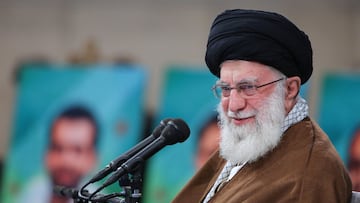Who is Ali Khamenei, Iran’s Supreme Leader? Political and religious views, age, family...
Ayatollah Seyyed Ali Khamenei is the Supreme Leader of Iran. We share some information about him and what his functions are.

Despite Iran’s government adopting the form of an “Islamic republic,” as per the 1979 Constitution, the president holds the position of the second-highest-ranking official, with the Supreme Leader at the pinnacle of the power structure.
Currently, Ayatollah Seyyed Ali Khamenei occupies this position.
Who is Ali Khamenei, Supreme Leader of Iran?
Below is a selection of information on Ali Khamenei:
- Date of birth: July 16, 1939
- Place of birth: Mashhad, Iran
- Full name: Seyyed Ali Khamenei
- Parents: Ayatollah Sayyid Jawad Husaini Khamenei and his mother's name is not mentioned.
- Family: Married in 1964, but his wife's name is not publicly known. He has six children: Mostafa, Mojtaba, Massoud, Maysam, Hoda and Boshra
- Education: studied with who would be Ayatollah Khomeini at the Islamic seminary in Qom, Iran.
- Religion: Islamic, Shia Muslim
According to the biography on the official website of the Supreme Leader, in English, he was born on July 16, 1939, in the holy city of Mashhad, in the province of Khorasan. Sayyed Ali is the second son of Sayyed Javad Khamenei.
At the age of four, Sayyed Ali and his older brother Mohammad were sent to maktab, the traditional primary schools of that time, to learn the alphabet and the Holy Quran. Later, he was transferred to a newly established Islamic school to continue his education.
After this primary education, Sayyed Ali continued his studies at the theological seminary of Mashhad.
He served as president of Iran between 1981 and 1989, and has been the Supreme Leader since he was appointed to succeed Ayatollah Khomeini in that position in June 1989.
Did you know?
— Visegrád 24 (@visegrad24) April 13, 2024
Ayatollah Ali Khamenei is 84 years old.
He has not left Iran since 1989. pic.twitter.com/lUTBjy0R6N
The functions of the Supreme leader in Iran
According to the Constitution of Iran, the Supreme Leader is responsible for outlining and overseeing the general policies of the state, setting the tone and direction of Iran’s internal and external policies. Additionally, he serves as the commander-in-chief of the armed forces and controls intelligence and security operations.
Related stories
According to Article 110 of the Constitution, these are the duties and powers of the Supreme Leader in Iran:
- Develop the general policies of the Islamic Republic of Iran
- Supervise the proper execution of the system's general policies.
- Issue a decree for a national referendum.
- Assume supreme command of the armed forces.
- Declare war and peace and mobilize armed forces.
- Appointment, dismissal and acceptance of resignation of several officials
- Resolve the differences between the three powers and regulate their relationships.
- Resolve system problems that cannot be solved by conventional methods
- Sign the decree that formalizes the election of the President of the Republic by the people.
- Removal of the President of the Republic, taking due account of the interests of the country, after the Court
- He has been found guilty by the Supreme Court of violating his constitutional duties, or after a vote by the Islamic Consultative Assembly.
- Pardon or reduce the sentences of those convicted, within the framework of Islamic criteria.
The Leader may delegate part of his duties and powers to another person.

Complete your personal details to comment